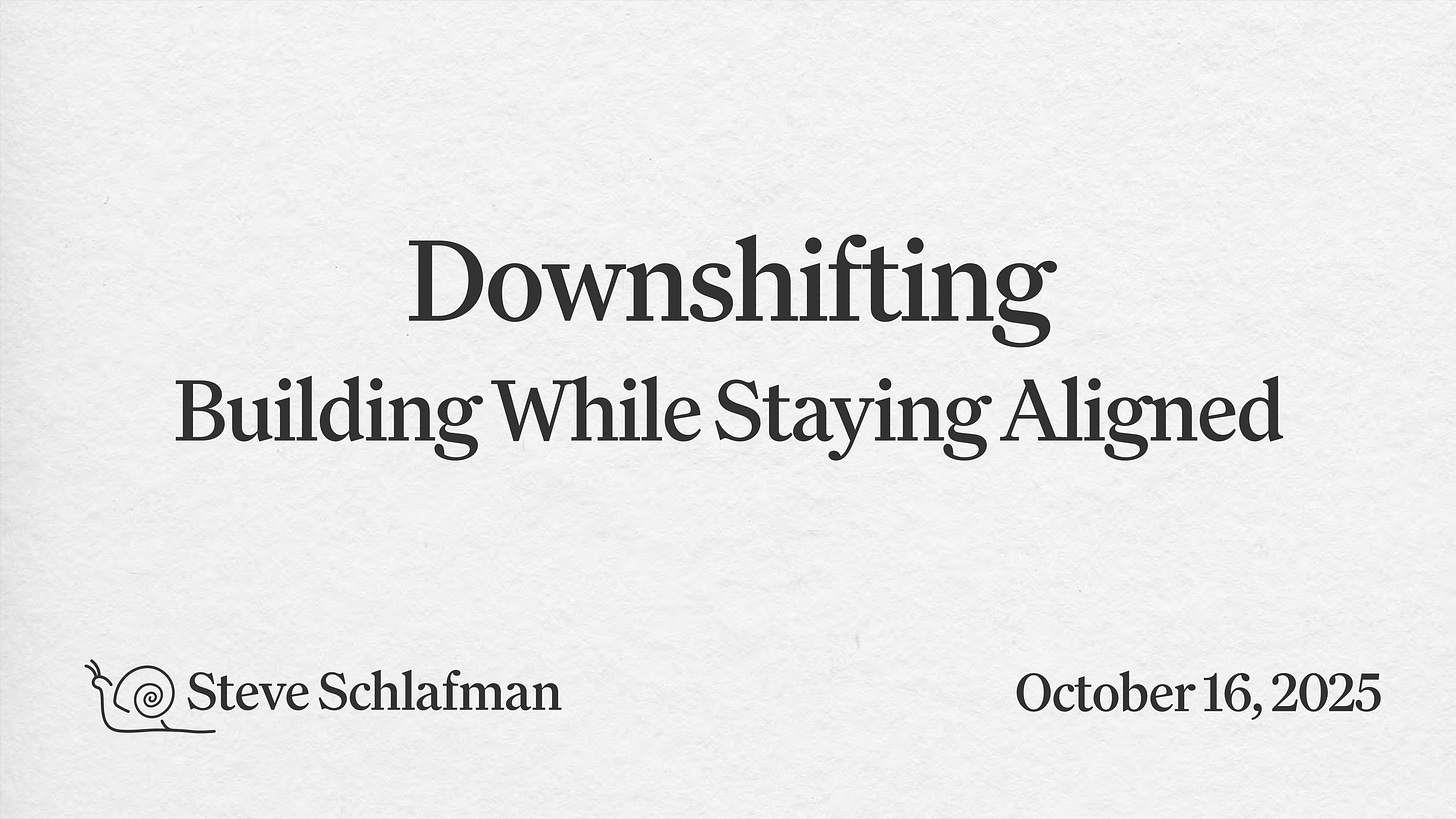Catching Misalignment Before It Becomes Burnout
What I Learned Teaching a Group of Solopreneurs About Downshifting
In the spring, my friend Justin Welsh and I went for a hike. He asked me to give a talk on downshifting for his Unsubscribe community.
I’m close with Justin and love teaching, but I almost said no and even rescheduled twice.
Justin’s audience is largely in what I call “upshift mode.” They’re solopreneurs launching, building, and scaling their businesses. These aren’t folks sitting around wondering what to do with their lives or whether to take a sabbatical. They generally know what they want and they’re going for it.
I told Justin, “I’m not sure it’s the right audience for my message.” But Justin pushed. “I think this could be really valuable for them. A lot of the group struggles with burnout and comparison. Just sit with it.”
I eventually said yes, then filed it away and tried not to think about it. Like any creative endeavor, I didn’t want to force it, but I trusted Justin and the process that’s worked for me before. Patience. Asking. Listening.
Two weeks ago, as the date drew closer, something essential clicked.
It dawned on me that I’ve been defining downshifting too narrowly all this time, as something you do after burnout, in transition away from hustle mode, or when you’re ready to redefine yourself and your career.
But that’s not what downshifting actually is. Or at least, it’s not only that.
Here’s what I realized:
Downshifting is a gear change—a momentary, periodic, or seasonal slowing down to create realignment.
Sometimes it’s 30 seconds, a few hours, 30 days, or in some cases longer. But the question is always the same: Is what I’m focused on expansive and energizing or constricting and draining? Am I still building and living what’s mine? Or have I drifted into something that belongs to someone else?
Downshifting is about making sure your life and ambition is pointed at the right thing. Your thing.
It doesn’t matter if you’re a burnt out executive, an ambitious founder early in your journey, or an investor wanting to play a different game. Every professional can and should do it.
But it’s especially critical for solopreneurs. I’ve learned over many years that we’re wired to move fast and build something that can sustain our lives. It makes sense—we don’t have a team to rely on, so most if not all of the strategy and execution falls on our shoulders. But when you move fast without pausing, it’s easy to drift into someone else’s lane, or hit a wall.
I know this territory better than most. I’m an ambitious solopreneur myself and I’ve burnt out multiple times pursuing someone else’s definition of success. I’ve also coached many others through it.
Here’s how it happens: We see projections of success on social media and think, I should do that. We adopt their strategies, their voice, their definition of winning. And before we know it, we’re building something that looks successful from the outside but doesn’t feel right on the inside.
That’s what no one talks about: spending years building the wrong thing while sacrificing our health and relationships in the process.
Last week I finally gave the talk. I spent 75 minutes with Justin and 25 solopreneurs from his community.
We covered:
What alignment actually feels like (and what misalignment feels like in your body)
The two types of burnout (overwork vs. misalignment—and why most people only know about the first one)
How drift happens (and why it’s so easy to miss when you’re moving fast)
The practice (how to check alignment daily, weekly, and quarterly so you catch it early)
What becomes possible when you’re aligned (flow instead of force, aliveness instead of depletion, yours instead of theirs)
The talk was energizing to give. Participants stayed after to ask more questions. A few folks reached out later to say it shifted something for them.
I’m sharing both the slides and the video here, in case it’s useful:
Here’s what I want to underscore: Downshifting isn’t about slowing down. It’s about deep personal integrity. It’s about playing your own game, not copying someone else’s. It’s about building and living on your own terms, even when that means doing something that doesn’t look like what everyone else is doing.
The hardest part is having the courage to pause and be honest with yourself about whether this still feels right. Most people never stop to ask. They keep building, grinding, and checking boxes until one day they wake up depleted and wondering why none of it feels right.
I’ve been there. I’ve pursued and attained success that wasn’t truly mine. But I’ve also reimagined and rebuilt from that place.
And I’ve never been more alive, more myself, or more successful. My coaching practice is thriving. My life feels expansive and creative. Alignment has given me clarity, agency, and peace. I’m finally playing my own game.
You don’t have to wait as long as I did. The same clarity and freedom are available to you when you choose to pause, listen, and align your life from the inside out.
If you watch this and something lands, hit reply. I’d love to hear from you.
—Steve





I was one of the folks from the Unsubscribe community that found your workshop and life work extremely valuable and very much aligned with my own philosophy. Thank you for what you do. It’s very much needed in the world 🙏🏻
Such a useful framework that, I would suggest, needs to be thought about by people who are retired or retired-adjacent.